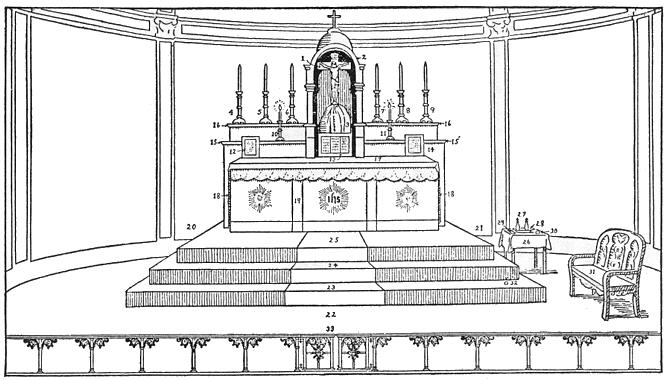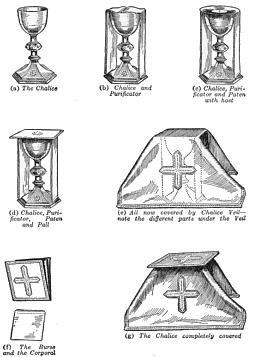

Menu

Observe well the picture of the altar and sanctuary. It is here that the Holy Sacrifice of the Mass is offered up. This picture shows everything that is necessary for Mass, and gives the proper name of the furniture of the sanctuary.

| (a) | Chalice | This is a cup made of gold or silver, or if of silver, the interior must be of gold. It holds the wine for the Holy Sacrifice, and is a striking figure of the Sacred Heart of Jesus. |
| (b) | Purificator | This is a linen cloth used for wiping the chalice, and the fingers and mouth of the celebrant after Communion. It is spread over the cup of the chalice at the beginning and end of Mass. |
| (c) | Paten | This is a plate of gold or silver upon which the large bread for consecration rests until the Offertory. Of old it was necessarily larger than now, for it held all the breads to be consecrated. |
| (d) | Pall | This is a square pocket-shaped piece of linen with a cardboard inserted in order to stiffen it. It is placed over the chalice to prevent dust or other matter falling into it. |
| (e) | Chalice Veil | This is the cloth which covers the chalice until the Offertory, and again after the Communion. It also is made of the same material and color as the vestments. |
| (f) | Burse
& Corporal |
The Burse is a square container for the corporal when the latter is not in use. It is made of the same material and color as the vestments. The Corporal is a square piece of linen. In size and appearance it resembles a small napkin. It is spread out on the altar, and the chalice is placed upon it. During the Mass the Sacred Host rests for a time on the Corporal. |
By God�s command the Jewish priests wore a distinctive garb when they ministered in the Temple. The Bible tells us they were vested in violet and purple, scarlet twice dyed, and fine linen. Gold and precious stones were also used to give the person of the priest that dignity demanded by his exalted office.No special dress was at first prescribed for the Christian priesthood. During the early days the garments worn at the Holy Sacrifice were not dissimilar in form to the clothing of civilians. They were distinguished, however, from profane apparel in richness and beauty of decorations; and, of course, their use was restricted to divine worship.
Secular fashion changed, but the Church clung to the old style. Thus it was that garments once common to all, presently became the privileged dress of the clergy. Faith then saw in each particular vestment a symbol relating to the Passion of Our Lord, and a reminder of some Christian duty.

| Vestment | Historical Origin | Symbolic Ref. | |
| (h) | Amice
The amice is a piece of fine linen in the form of an oblong. The priest places it for a moment on his head, and then allows it to rest upon his shoulders. As he does so he prays: �Place, O Lord, on my head the helmet of salvation, that so I may resist the assaults of the devil.� |
A covering for the head and neck worn like a hood. When indoors it was lowered and thrown over the shoulders. | (a) The linen cloth that the soldiers put over Our Lord�s head; when thus blindfolded. He was mockingly asked who struck Him. (b) The helmet of Salvation (Cf. Ephes. 6:17) |
| (i) | Alb
A wide linen robe reaching to the feet and covering the whole body. The vesing prayer is: �Make me white, O Lord, and cleanse my heart; that being made white in the Blood of the Lamb I may deserve an eternal reward.� |
The alb, or tunic, was worn in ancient times by all who enjoyed any dignity. | (a) The garment with which Herod clothed Our Lord. (b) Signifies the purity of conscience demanded of God�s priests. |
| (j) | Cincture
The cincture, or girdle, is a cord of linen fastened about the waist to confine the alb. The vesting prayer is: �Gird me, O Lord, with the cincture of purity, and quench in my heart the fire of concupiscence, that the virtue of continence and chastity may abide in me.� |
Walking and active exertion made it necessary for one to gird up a long garment like the alb. Hence the cincture was an essential article of dress. | (a) The cord that bound Our Lord to the pillar when He was being scourged. (b) Symbolizes modesty, and also readiness for hard work in God�s service. |
| (k) | Maniple
A strip of silken cloth worn on the left arm of the priest. The vesting prayer is: �May I deserve, O Lord, to bear the maniple of weeping and sorrow in order that I may joyfully reap the reward of my labors.� |
Originally a strip of linen worn over the arm. During the long services, and in the intense heat of southern countries its use was frequently necessary to wipe the perspiration from the face and brow. | (a) The rope whereby Our Lord was led, and the chains which bound His sacred hands. (b) An emblem of the tears of penance, the fatigue of the priestly office and its joyful reward in heaven. |
| (l) | Stole
A long band of silk of the same width as the maniple, but three times its length. It is worn around the neck and crossed on the breast. The vesting prayer is: �Restore to me, O Lord, the state of immortality which I lost through the sin of my first parents and, although unworthy to approach Thy Sacred Mysteries, may I deserve nevertheless eternal joy.� |
A kind of neck-piece or kerchief; a part of the dress of the upper classes. It gradually became the distinctive mark of spiritual authority in the higher clerics, viz., the priest and deacon. | (a) The cords with which Jesus was tied. Worn as it is over the shoulders, it reminds us, too, of the cross Our Lord carried. (b) A reminder of the yoke of Christ. The priest�s burden is a heavy one, which Christ nevertheless makes sweet. |
| (m) | Chasuble
The chasuble is the outer and chief vestment of the priest. It is essentially the Mass vestment and is now exclusively reserved to the priest. The vestment is familiar to all by reason of the cross usually embroidered on it. The vesting prayer is: �O Lord, who has said, �My yoke is sweet and My burden light,� grant that I may so carry it as to merit Thy grace.� |
Imagine a large circular cloth with a hole cut in the center for the head. This will help one to visualize the ancient chasuble, which was an immense cloak, over the head and completely enveloped the body. When it was necessary to use the hands, the garment had to be folded up on each side over the arms. Because of its inconvenience (for two assistants were needed to manipulate it), the vestment was gradually cut and altered until it now has its present shape. It is usually ornamented with a large cross on the back, and sometimes on the front of the garment (fig n.). We occasionally see chasubles made in the Gothic or Medieval style. These are more ample and drape over the shoulders down to the wrists. The cross on such chasubles has the shape of the letter �Y,� the top arms of which extend over the shoulders towards the front. (Editors Note: Pope Pius XIII has decreed that Gothic chasuble NOT be purchased for use in the Mass. However, existing Gothic chasubles may be used until they wear out.) | (a) The purple cloak worn by Our Lord when He stood before Pilate. (b) An emblem of love. When the ordaining bishop gives it to the new priest, he says: �Receive the priestly garment, for the Lord is Powerful to increase in you love and perfection.� |
.